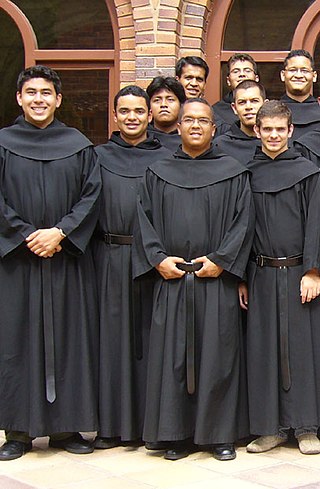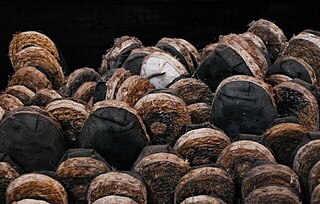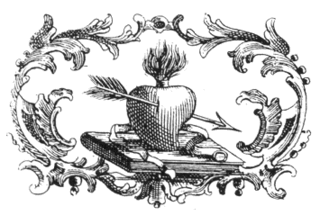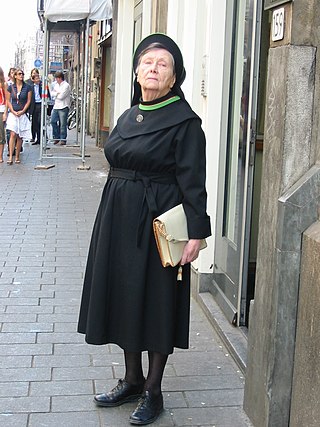
The Order of the Brothers of the Blessed Virgin Mary of Mount Carmel, known as the Carmelites or sometimes by synecdoche known simply as Carmel, is a mendicant order in the Roman Catholic Church for both men and women. Historical records about its origin remain uncertain; it was probably founded in the 12th century on Mount Carmel.

Augustinians are members of several religious orders that follow the Rule of Saint Augustine, written in about 400 AD by Augustine of Hippo. There are two distinct types of Augustinians in Catholic religious orders dating back to the 12th–13th centuries:

A friar is a member of one of the mendicant orders in the Roman Catholic Church. There are also friars outside of the Roman Catholic Church, such as within the Anglican Communion. The term, first used in the 12th or 13th century, distinguishes the mendicants' itinerant apostolic character, exercised broadly under the jurisdiction of a superior general, from the older monastic orders' allegiance to a single monastery formalized by their vow of stability. A friar may be in holy orders or be a non-ordained brother. The most significant orders of friars are the Dominicans, Franciscans, Augustinians, and Carmelites.

The Scapular of Our Lady of Mount Carmel belongs to the habit of both the Carmelite Order and the Discalced Carmelite Order, both of which have Our Lady of Mount Carmel as their patroness. In its small form, it is widely popular within the Latin Church of the Catholic Church as a religious article and has probably served as the prototype of all the other devotional scapulars. The liturgical feast day of Our Lady of Mount Carmel, July 16, is popularly associated with the devotion of the Scapular.

The Servite Order, officially known as the Order of Servants of Mary, is one of the five original mendicant orders in the Roman Catholic Church. It includes several branches of friars, contemplative nuns, a congregation of religious sisters, and lay groups. The order's objectives are the sanctification of its members, the preaching of the Gospel, and the propagation of devotion to the Mother of God, with special reference to her sorrows. The Servites friars lead a community life in the tradition of the mendicant orders.

The term third order signifies, in general, lay members of Christian religious orders, who do not necessarily live in a religious community such as a monastery or a nunnery, and yet can claim to wear the religious habit and participate in the good works of a great order. Roman Catholicism, Lutheranism and Anglicanism all recognize third orders.

The Third Order of Our Lady of Mount Carmel, also known as the Lay Carmelites, is a third order of the Carmelite Order of the Ancient Observance, established in 1476 by a bull of Pope Sixtus IV. It is an association of people who choose to live the Gospel in the spirit of the Carmelite Order and under its guidance. Its members are mainly lay people.

Simon Stock, OCarm was an English Catholic priest and saint who lived in the 13th century and was an early prior of the Carmelite order. The Blessed Virgin Mary is traditionally said to have appeared to him and given him the Carmelite habit, the Brown Scapular. Thus, popular devotion to Stock is usually associated with devotion to Our Lady of Mount Carmel.
The Canons Regular of St. Augustine are priests who live in community under a rule and are generally organised into religious orders, differing from both secular canons and other forms of religious life, such as clerics regular, designated by a partly similar terminology. As religious communities, they have laybrothers as part of the community.

The Order of Discalced Augustinians is a mendicant order that branched off from the Order of Saint Augustine as a reform movement.

The Discalced Carmelites, known officially as the Order of the Discalced Brothers of the Blessed Virgin Mary of Mount Carmel or the Order of Discalced Carmelites, is a Catholic mendicant order with roots in the eremitic tradition of the Desert Fathers. The order was established in the 16th century, pursuant to the reform of the Carmelite Order by two Spanish saints, Teresa of Ávila (foundress) and John of the Cross (co-founder). Discalced is derived from Latin, meaning "without shoes".
A Catholic order liturgical rite is a variant of a Catholic liturgical rite distinct from the typical ones, such as the Roman Rite, but instead specific to a certain Catholic religious order.

A discalced religious order is one whose members go barefoot or wear sandals. These orders are often distinguished on this account from other branches of the same order. The custom of going unshod was introduced into the West by Saint Francis of Assisi for men and by Saint Clare of Assisi for women.

The Crutched Friars were a Roman Catholic religious order in England and Ireland. Their name is derived from a staff they carried with them surmounted by a crucifix. There were several orders devoted to the Holy Cross, collectively known as Crosiers, that had some presence in England and there is much confusion to which specific order the friars belonged. Earlier literature linked most of the Crutched Friars to the Italian Crosiers, but later it was proven that they were a branch of the Belgian Canons Regular of the Order of the Holy Cross. The Crutched Friars were suppressed during the Dissolution of the Monasteries in 1538.
Independent Augustinian communities are Roman Catholic religious communities that follow the Augustinian Rule, but are not under the jurisdiction of the Prior General of the Augustinian hermits in Rome.

The Order of Augustinian Recollects (OAR) is a mendicant Catholic religious order of friars and nuns. It is a reformist offshoot from the Augustinian hermit friars and follows the same Rule of St. Augustine. They have also been known as the "Discalced Augustinians".

The Order of Saint Augustine, abbreviated OSA, is a religious mendicant order of the Catholic Church. It was founded in 1244 by bringing together several eremitical groups in the Tuscany region who were following the Rule of Saint Augustine, written by Saint Augustine of Hippo in the fifth century.

Augustinian nuns are the most ancient and continuous segment of the Roman Catholic Augustinian religious order under the canons of contemporary historical method. The Augustinian nuns, named after Saint Augustine of Hippo, are several Roman Catholic enclosed monastic communities of women living according to a guide to religious life known as the Rule of St. Augustine. Prominent Augustinian nuns include Italian mystic St. Clare of Montefalco and St. Rita of Cascia.
The Brothers of Penitence or Friars of the Sack were an Augustinian community also known as Boni Homines or Bonshommes, with houses in Spain, France and England.
When referring to Roman Catholic religious orders, the term Second Order refers to those communities of contemplative cloistered nuns which are a part of the religious orders that developed in the Middle Ages.

















